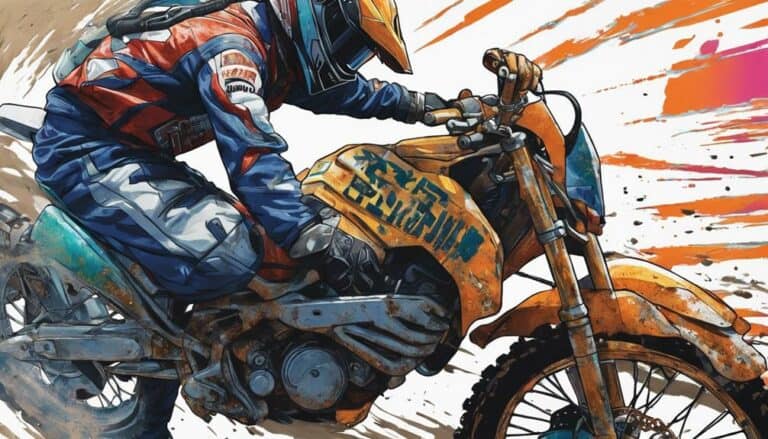When it comes to tackling those unsightly sandpaper scratches on your dirt bike plastic, the solution may be simpler than you think.
Imagine being able to restore your plastic to its former glory without extensive costs or professional help.
By following a few straightforward steps, you can achieve remarkable results and have your dirt bike looking as good as new.
So, how exactly can you make those scratches disappear and revamp your ride's appearance?
Key Takeaways
- Identify sandpaper scratches by checking for hazy spots and running a fingernail to determine depth.
- Gather necessary materials like fine grit sandpaper, heat gun, polishing compound, and clean cloth.
- Prepare dirt bike plastic by cleaning thoroughly, ensuring a dry surface for scratch removal.
- Remove scratches by wet sanding, buffing with polishing compound, and applying protective polish or wax.
Identifying the Sandpaper Scratches
How can you accurately pinpoint the sandpaper scratches on your dirt bike plastic under direct light?
When examining your dirt bike plastic under direct light, observe the surface closely. Light scratches caused by sandpaper will typically manifest as hazy or dull spots on the plastic. These scratches are superficial and don't affect the structural integrity of the plastic but can impact its overall appearance.
To identify deeper scratches, run your fingernail across the surface. If your nail catches on a scratch, it indicates a deeper cut that may require more extensive restoration. Understanding the depth and extent of the scratches is essential in determining the appropriate method for removal.
In some cases where the scratches are too severe or numerous, it might be more practical to contemplate purchasing new plastic components for your dirt bike. By accurately evaluating the scratches, you empower yourself to make informed decisions on how best to restore your dirt bike plastic to its former glory.
Gathering the Necessary Materials
To gather the necessary materials for removing scratches from dirt bike plastic, start by collecting fine grit sandpaper ranging from 800 to 2000 grit. This specific grit range is ideal for effectively sanding down scratches without causing further damage to the plastic surface.
Additionally, make sure you have a heat gun or propane torch on hand to heat the plastic gently for restoration purposes. The heat helps the plastic become more malleable, making it easier to remove scratches.
Apart from this, have polishing compound and a clean microfiber cloth ready for buffing out scratches and restoring the shine of the plastic after sanding.
Remember to prepare a bucket of warm soapy water for cleaning the plastic both before and after scratch removal to ensure a clean surface for restoration work.
Preparing the Dirt Bike Plastic
Start by thoroughly cleaning the dirt bike plastic to eliminate any dirt, grime, or debris before proceeding with the scratch removal process. Use a plastic cleaner or mild soap to make certain the surface is free of any contaminants that could interfere with the repair. Inspect the plastic surface carefully to assess the extent of the scratches and determine the appropriate restoration method.
After cleaning, make sure the plastic is completely dry before attempting to remove sandpaper scratches. Moisture can affect the effectiveness of the scratch removal process, so allow the plastic to air dry thoroughly. Consider using a soft cloth or microfiber towel to gently wipe down the plastic, ensuring a smooth and clean surface that will aid in the scratch removal.
Removing the Sandpaper Scratches
To effectively remove sandpaper scratches from dirt bike plastic, start by wet sanding the scratched area with fine grit sandpaper in a circular motion. This process helps to gradually diminish the scratches without causing further damage to the plastic surface. Make sure you maintain a consistent pressure and keep the sandpaper wet to prevent overheating and melting of the plastic. Periodically check the progress to track how the scratches are fading away.
Once the scratches are less noticeable, use a polishing compound to buff out any remaining imperfections and restore a smooth finish to the plastic. This step further refines the surface and prepares it for the final touches. Apply a plastic polish or wax to enhance the shine and provide a protective layer against future scratches.
Repeat the sanding and polishing process as necessary until you achieve the desired results. Remember, patience and attention to detail are key when working on plastic surfaces to guarantee a professional finish.
Finishing Touches and Maintenance
For a careful finish that guarantees the longevity and appearance of your dirt bike plastic, incorporate these essential finishing touches and maintenance steps. After removing sandpaper scratches, it is important to give your plastic a polished look that will stand the test of time. Here's a detailed guide to help you achieve that flawless finish:
| Step | Description | Purpose |
|---|---|---|
| Polishing | Use a polishing compound after sanding to restore the shine and smooth out any remaining imperfections. | Enhances the overall appearance of the plastic. |
| Protective Coating | Apply a protective coating or wax to maintain the finish and prevent future scratches. | Preserves the plastic and keeps it looking new. |
| Final Inspection | Check for any overlooked imperfections and address them promptly to ensure a flawless surface. | Ensures that the plastic is in the best condition it's going to look. |
Conclusion
To sum up, by following the steps outlined in this guide, you can easily remove sandpaper scratches from your dirt bike plastic and restore its appearance.
Did you know that 85% of dirt bike owners experience scratches on their plastic at some point?
By taking proper care of your bike and using the right techniques, you can keep it looking like new for years to come.
Happy riding!

